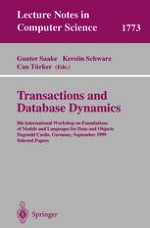2000 | OriginalPaper | Buchkapitel
Open Nested Transactions: A Support for Increasing Performance and Multi-tier Applications
verfasst von : Malik Saheb, Ramzi Karoui, Simone Sedillot
Erschienen in: Transactions and Database Dynamics
Verlag: Springer Berlin Heidelberg
Enthalten in: Professional Book Archive
Aktivieren Sie unsere intelligente Suche, um passende Fachinhalte oder Patente zu finden.
Wählen Sie Textabschnitte aus um mit Künstlicher Intelligenz passenden Patente zu finden. powered by
Markieren Sie Textabschnitte, um KI-gestützt weitere passende Inhalte zu finden. powered by
The two-phase commit protocol is combined with the strict two-phase locking protocol as means for ensuring atomicity and serializability of transactions. The implication of this combination on the length of time a transaction may holding locks on various data items might be severe. There are certain classes of applications where it is known that resources acquired within a transaction can be “released early”, rather than having to wait until the transaction terminates. Furthermore, there are applications involving heterogeneous competing business organizations, which do not allow to block their resources; therefore, the preservation of local autonomy of individual systems is crucial. This paper describes an extension of the OMG’s Object Transaction Service, by adding the “open nested transaction model”, which greatly improves transaction parallelism by releasing the nested transaction locks at the nested transaction commit time. Open nested transactions relax the isolation property by allowing the effects of the committed nested transaction to be visible to concurrent transactions. We also describe how we take benefit of this model using the proposed Asynchronous Nested Transaction model to overcome the limits of the current messaging products and standard specifications when they are confronted with the problem of guaranteeing the atomicity of distributed multi-tier transactional applications.
